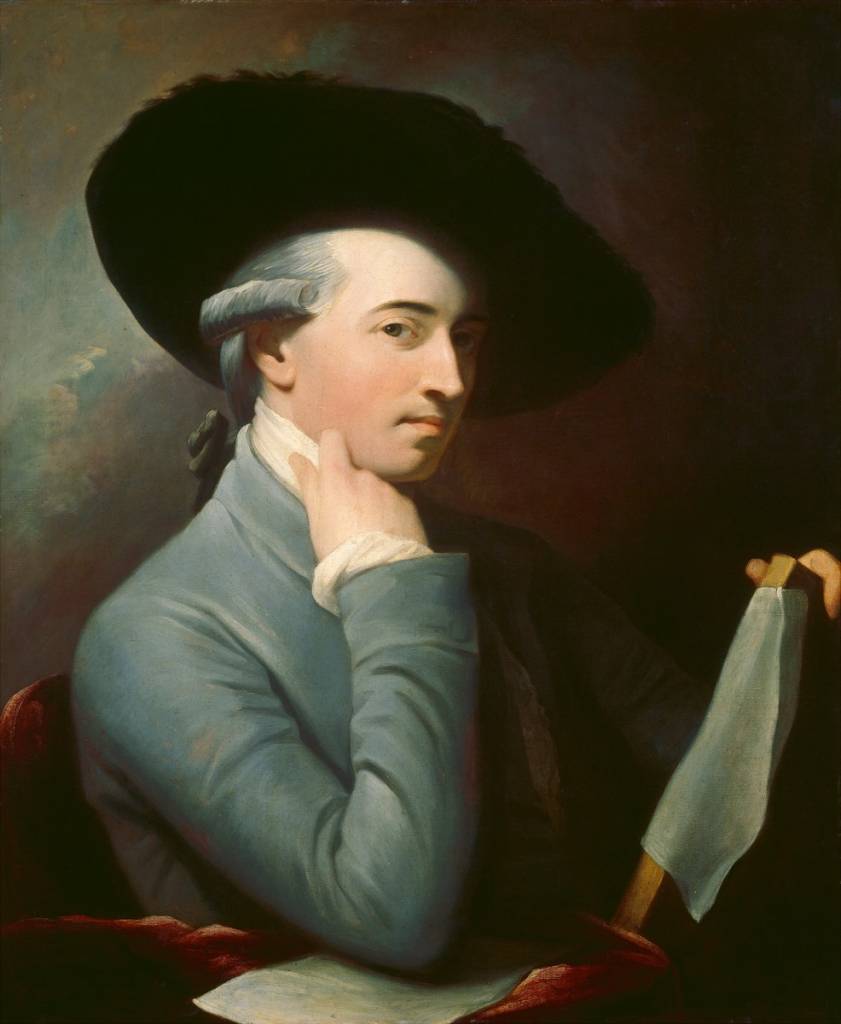
Self-Portrait of Benjamin West, 1776 | oil on canvas | National Gallery of Art, Washington DC | Andrew W. Mellon Collection
Most of us can recall the names of famous Americans from the Colonial era, many of whom would later be known as “Founding Fathers.” Names like Benjamin Franklin, Paul Revere, William Penn, and George Washington conjure images of esteemed men of olden times whose likenesses have forever been committed to canvas or cast in bronze. Heck, even the revolutionary Samuel Adams peers at us from a beer label these days. But what about the important artists of the same era? Do we know their names as well, or equally, recognize their images?
Meet Benjamin West, born on October 10, 1738, and widely considered to be America’s first great fine-art painter. Most visitors to Crystal Bridges will remember West’s captivating painting Cupid and Psyche (1808), on view in our Colonial to Early Nineteenth-Century Gallery, which was painted late in his career.
West was born in Springfield, Pennsylvania, the tenth child to an innkeeper and his wife. He showed a natural affinity for art as a child, and in his memoir The Life and Studies of Benjamin West (1816, 1820), he recalled that Native Americans taught him how to create paints by mixing clay from the river bank with bear grease in a pot. He was never formally trained as a painter before embarking on a career of painting portraits throughout Pennsylvania from 1746-1759.
A portrait of Benjamin West’s patron, Dr. William Smith, provost of the College of Pennsylvania, painted by one of West’s most famous students, Gilbert Stuart.

Gilbert Stuart, 1755-1828
William Smith
Ca. 1801-1802
Oil on canvas
Crystal Bridges Museum of American Art
West’s talents eventually caught the eye of Dr. William Smith, the provost of the then College of Pennsylvania in Philadelphia. Through this introduction, West built a valuable network of connections and subsequent commissions, including a close friendship with Benjamin Franklin and the patronage of a wealthy Philadelphian named William Allen. In 1760, thanks to the sponsorship of Smith and Allen, West traveled to Europe, embarking on the “Grand Tour” of important museums and cultural heritage sites of Europe. In 1763 he arrived in England for what was meant to be his last stop before returning to America. He remained in London for the rest of his life.
A main reason for West’s decision to settle in England was his burgeoning popularity and ability to attract esteemed patronage, which eventually included King George III. Living in London allowed West to ambitiously pursue history painting, which involved creating large scenes of heroic battles, Biblical stories, mythological fables, and other tales from the past. In 1768, King George III appointed West to the Royal Academy of Arts in London and in 1772, West became the Crown’s official historical painter—not bad for a boy from the British Colonies in America.
Because of West’s pride in his colonial American heritage, he always welcomed into his studio young American artists traveling abroad, offering both a place to stay and valued instruction from one of the most prestigious painters in Britain. In fact, one of West’s greatest legacies is arguably the many early American artists who excelled under his tutelage, which include Charles Willson Peale, Rembrandt Peale, John Singleton Copley, Thomas Sully, Samuel F.B. Morse, and Gilbert Stuart—all of whom are featured in Crystal Bridges’ collection.

Benjamin West (1738-1820)
Cupid and Psyche
1808
Oil on canvas
Crystal Bridges Museum of American Art, Bentonville, Arkansas
Benjamin West’s influence on early American art, and thus the American art tradition, cannot be overstated. His students went on to found The Pennsylvania Academy of Fine Arts in Philadelphia, the first professional art school in the United States, and the Royal Academy of Design in New York, itself modeled on the Royal Academy in London, of which West served as President for over two decades. His work can be viewed in dozens of major art institutions throughout the world, and especially the United States and Great Britain. Come visit our own Benjamin West masterpiece, Cupid and Psyche (1808), on view now in our Colonial to Early Nineteenth Century Gallery.



